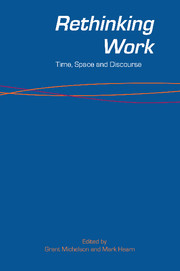Book contents
- Frontmatter
- Contents
- Tables and Figure
- Contributors
- Editorial Statement
- Abbreviations
- 1 Going to a New Place
- PART I TIME
- PART II SPACE
- PART III DISCOURSE
- 11 The National Narrative of Work
- 12 Shareholder Value and Corporate Social Responsibility in Work Organisations
- 13 Rethinking HRM
- 14 Identifying the Subject
- 15 Constructing Older Workers
- COMMENTARY
- Index
15 - Constructing Older Workers
Cultural Meanings of Age and Work
Published online by Cambridge University Press: 05 June 2012
- Frontmatter
- Contents
- Tables and Figure
- Contributors
- Editorial Statement
- Abbreviations
- 1 Going to a New Place
- PART I TIME
- PART II SPACE
- PART III DISCOURSE
- 11 The National Narrative of Work
- 12 Shareholder Value and Corporate Social Responsibility in Work Organisations
- 13 Rethinking HRM
- 14 Identifying the Subject
- 15 Constructing Older Workers
- COMMENTARY
- Index
Summary
Older workers have been attracting increasing public, government, academic and organisational interest over the last two decades. Demographic projections are often cited to emphasise the importance of the issue, for example the International Labour Organisation has estimated that by 2025, 32 per cent of the population in Europe will be over 55 years compared to 30 per cent in North America, 21 per cent in Asia, and 17 per cent in Latin America (Ilmarinen 2001). In the year 2000, the median age of a worker in the USA was 40 years, the age at which they are considered to be an ‘older worker’ under the Age Discrimination and Employment Act (McMahan & Phillips 2000). More broadly, the consequences of population ageing constitute a central concern for advanced industrialised countries; for example, the proportion of the Japanese population over 65 years is currently 20 per cent and by 2025 it is expected to increase to 29 per cent, and 36 per cent by 2050 (Pearson 2003), while in Australia, forecasts project that by 2021 more than 20 per cent of the population will be over 65 years (Encel 2003). As a result, governments and organisations in many countries are concerned with the implications of an older workforce and its potential impact on economic growth, productivity, labour and skill shortages. It is, however, arguably the economic effects of supporting ageing populations that preoccupies governments.
- Type
- Chapter
- Information
- Rethinking WorkTime, Space and Discourse, pp. 308 - 328Publisher: Cambridge University PressPrint publication year: 2006
- 5
- Cited by

